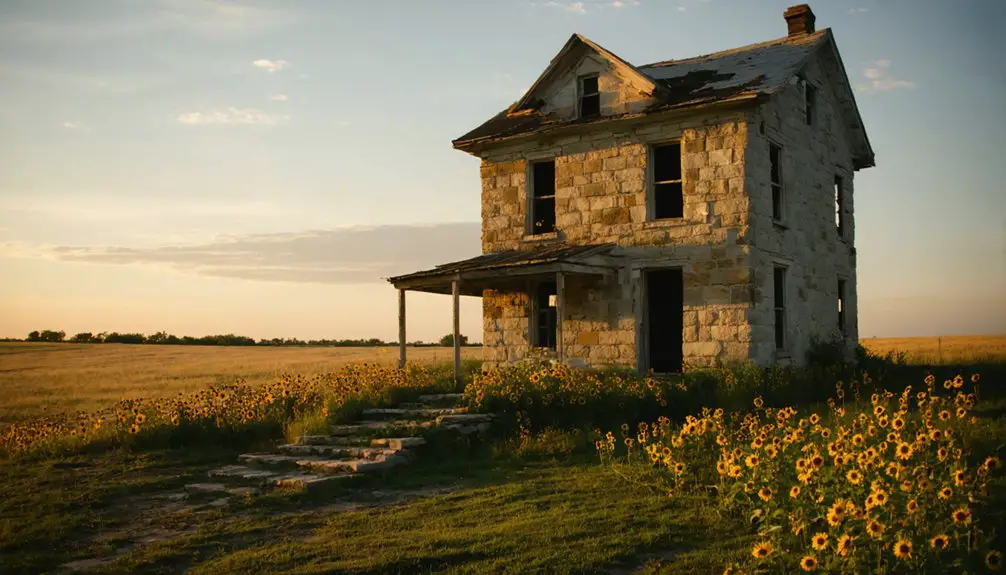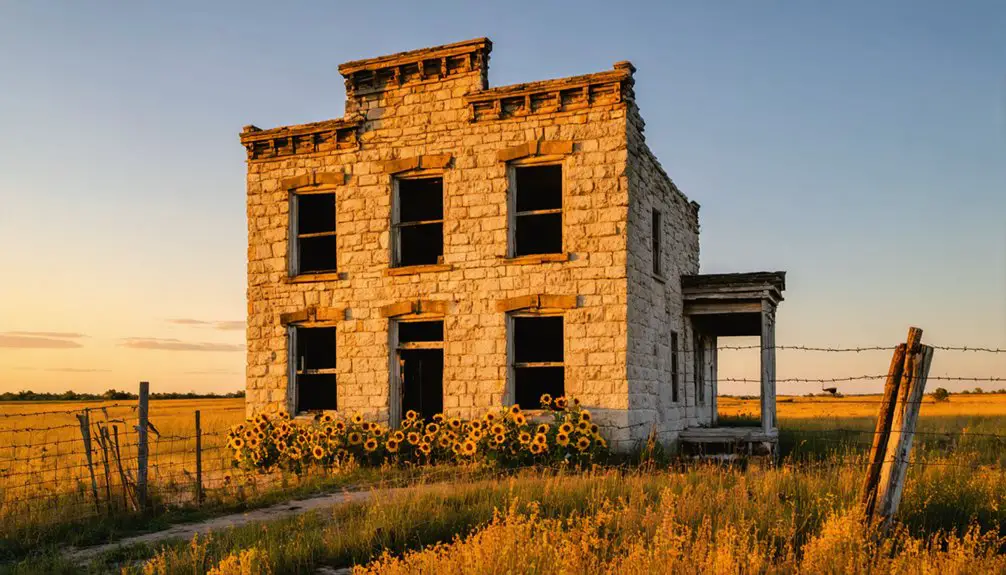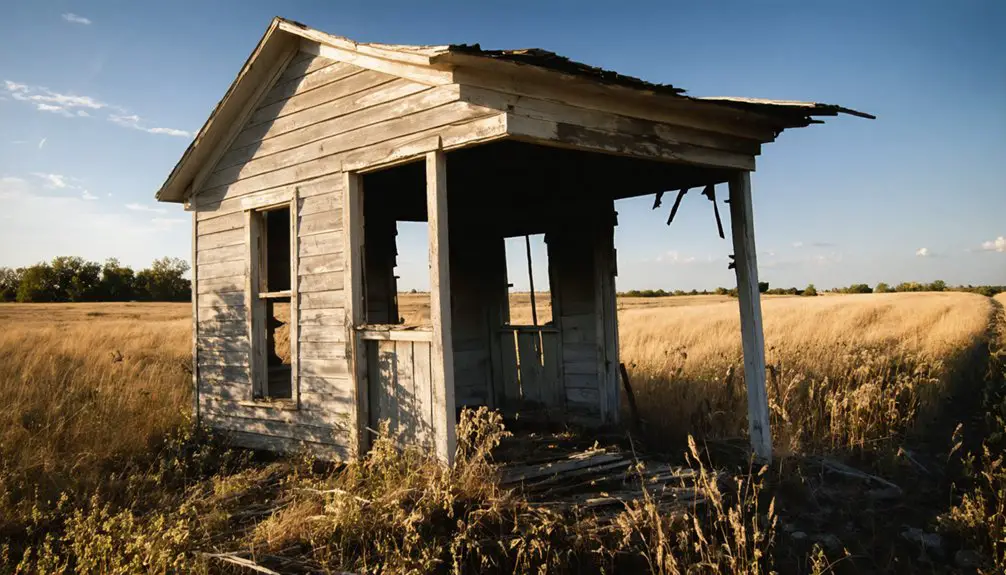You’ll find Six-Mile House in eastern Wyandotte County, Kansas, where Joseph A. Bartles established a notorious tavern in 1853. Located six miles from Wyandotte’s Kansas River ferry crossing, this two-story structure featured nine rooms and black walnut architecture with hidden compartments. During Bleeding Kansas and the Civil War, it served as a stagecoach stop, Underground Railroad waypoint, and base for Union guerrillas known as Red Legs. The tavern’s thick stone walls still hold untold stories of frontier justice and daring escapes.
Key Takeaways
- Six-Mile House was established in 1853 as a frontier tavern in eastern Wyandotte County, Kansas, serving as a stage coach stop.
- Built with thick stone walls and secret compartments, the tavern featured nine rooms and high-quality black walnut construction.
- The establishment played multiple roles during Bleeding Kansas as a makeshift courtroom, vigilante justice center, and Underground Railroad waypoint.
- Located strategically six miles from Wyandotte’s Kansas River ferry crossing, it served as a base for Union guerrilla forces during the Civil War.
- Despite its historical significance during Kansas Territory’s formative years, Six-Mile House eventually became abandoned as the frontier developed.
Origins and Early Settlement
Located in eastern Wyandotte County, Kansas, Six-Mile House emerged from land originally inhabited by the Wyandot and Delaware tribes. Joseph A. Bartles purchased the property from a Wyandotte Indian, establishing what would become an essential stage tavern for travelers braving the untamed territory.
The early inhabitants faced significant settlement challenges in this rugged landscape. You’ll find that the area’s dense forests, deep ravines, and steep hills created natural barriers that both hindered development and provided strategic advantages. The Kimball, Moore & Co. stage line regularly transported passengers through this challenging terrain. Like the settlers of Columbia, Kansas, they faced uncertainty over their land claim rights until official surveys were completed.
While these geographical features made farming and building difficult, they also offered perfect hiding spots for various groups, including Bushwhackers and deserters. The untamed environment, combined with its proximity to the Missouri border, created a frontier atmosphere where lawlessness thrived, prompting citizens to establish their own systems of justice.
The Notorious Tavern’s Rise
When Joseph A. Bartles and his son Theodore founded Six-Mile Tavern in 1853, they’d create more than just another waystation near Quindaro, Kansas.
The tavern’s strategic location, exactly six miles from Wyandotte’s Kansas River ferry crossing, made it a essential first horse-changing stop on the express stage route.
Situated precisely six miles from the Wyandotte ferry, this vital waystation offered fresh horses to weary stage travelers.
The Bartles family constructed an impressive two-story building with tavern architecture that featured nine spacious rooms and high-quality black walnut throughout – from the floors to the elaborate barroom. Like the historic Pennsylvania Six Mile House, it was built with thick stone walls that helped insulate the structure from harsh weather.
Hidden compartments and a wine cellar added intrigue to the structure.
While it served legitimate travelers along the important transportation route between Wyandotte and Leavenworth, the tavern quickly gained notoriety as a gathering place for Red Legs and other militant groups, who took advantage of its secret closets for storing arms and ammunition. During the turbulent Bleeding Kansas period, the tavern witnessed numerous conflicts between pro-slavery and anti-slavery factions.
Life During Bleeding Kansas
During Bleeding Kansas, you’d find Six-Mile House caught in the crossfire between proslavery and antislavery factions, as the territory descended into lawlessness with frequent raids and vigilante killings along the Kansas-Missouri border.
You couldn’t trust your neighbors as guerrilla warfare intensified, with both sides targeting taverns and gathering spots suspected of harboring their enemies. Free-soil forces from the North organized armed groups to protect their settlements, making the territory even more dangerous.
Local justice became a brutal affair as residents took the law into their own hands, transforming roadhouses like Six-Mile House into makeshift courtrooms where summary executions weren’t uncommon. The escalating violence mirrored the larger territorial conflict that began with the Kansas-Nebraska Act in 1854.
Lawless Territory and Violence
As tensions between proslavery and free-state factions reached a breaking point in 1856, Kansas Territory descended into a period of unprecedented violence and lawlessness.
You’d find territorial law enforcement either unable or unwilling to maintain order, often participating in the violence themselves. Proslavery territorial legislature at Lecompton fueled further resistance and unrest. The chaos peaked when over 700 proslavery men attacked Lawrence, burning the Free-State Hotel and destroying printing presses.
In response, John Brown’s brutal raid at Pottawatomie Creek sparked nearly four months of intense bloodshed. Guerrilla warfare tactics resulted in approximately 200 deaths throughout Kansas Territory.
Civilians bore the brunt of this turmoil. You might’ve lost your home to arson, faced violent eviction, or witnessed your neighbors killed in raids.
Entire communities suffered as both sides engaged in revenge killings, property destruction, and organized violence that shattered the territory’s stability.
Guerrilla Warfare Intensifies
Since Kansas Territory lacked effective law enforcement in 1855, guerrilla warfare quickly became the primary means of settling ideological disputes between pro-slavery and free-state factions.
Political violence escalated as both sides employed guerrilla tactics to control the region’s future.
The daily reality of life in Kansas Territory during this period included:
- Border Ruffians from Missouri conducting raids on free-soil settlements
- John Brown and other abolitionists launching retaliatory attacks against pro-slavery households
- Local families facing robbery, arson, and assassination threats from both sides
- Trade disruption and economic instability forcing many settlers to abandon their homes
Ordinary people suffered immensely as the cycle of violence continued between the two states.
With approximately 56 deaths attributed to the conflict, the violence transformed Kansas Territory into a proving ground for the brutal guerrilla warfare tactics that would later characterize portions of the Civil War.
The violence intensified after the passing of the Kansas-Nebraska Act in May 1854, which allowed settlers to determine whether their territory would be free or slave through popular sovereignty.
Vigilante Justice Takes Hold
While formal law enforcement proved largely ineffective in Wyandotte County between 1859-1861, vigilante justice emerged as citizens’ primary response to unchecked criminal activity.
With thirteen murders going unpunished and rampant robberies, horse thefts, and kidnappings of free blacks plaguing the region, vigilante motivations stemmed from a desperate need for order.
You’d find community justice centered around Six-Mile House, where local citizens formed a “Committee of Safety” to combat the outlaws who used the tavern’s secret rooms and surrounding terrain as their base.
Mass meetings at the Wyandotte courthouse led to organized vigilante actions, including public horsewhippings and hangings.
These harsh measures reflected the area’s charged political climate during Bleeding Kansas, as pro-slavery and anti-slavery factions clashed violently in the absence of effective legal authority.
Underground Railroad Connections

You’ll find Six-Mile House‘s strategic position near both Quindaro’s essential river crossing and the Wyandotte ferry made it a natural waypoint in the Underground Railroad network linking Missouri to Kansas Territory.
The tavern’s secret closets and wine cellar, combined with its location six miles from the Kansas River crossing, provided critical infrastructure for sheltering fugitives escaping bondage via the Missouri River blockades.
Its placement along the stagecoach route between Wyandotte and Leavenworth created a lifeline for freedom seekers moving inland after reaching the “Canada of the escaped slave” at nearby Quindaro.
Strategic River Route Locations
During the Underground Railroad era, Kansas Territory’s river systems formed crucial escape corridors for freedom seekers moving northward.
You’ll find strategic river crossings and ferry routes positioned along the Kansas and Missouri Rivers, with key locations like Lawrence Ferry Crossing at Locust and 2nd Street serving as essential transit points.
- Natural crossings at Mill Creek near Maple Hill guided escapees toward Wabaunsee County stations
- Mount Mitchell’s route near the Kaw Valley provided water access and natural cover
- River-adjacent settlements like Lawrence, Topeka, and Holton offered shelter and supplies
- The “Lane Trail” utilized river confluences, connecting Kansas to Nebraska and Iowa’s freedom networks
These waterways helped you avoid detection while moving between settlements, using the river systems as natural navigational guides toward liberty.
Abolitionist Safe House Network
As anti-slavery sentiment took root in Kansas Territory, a network of safe houses emerged around Six-Mile House and Quindaro, creating essential escape corridors for enslaved people fleeing north.
You’ll find that abolitionist networks strategically established locations along the Parkville-Quindaro route, using buildings with hidden rooms and secret passages to protect freedom seekers from Border Ruffians.
Quindaro became known as the “Canada of the escaped slave,” while nearby establishments like Six-Mile House, built in 1853, offered potential shelter along the dangerous journey.
Safe house strategies included using disguises, deception, and the cover of darkness to move people deeper into free territory.
The National Kansas Aid Committee helped coordinate these efforts, working with Quakers and other abolitionists to maintain escape routes until at least 1864.
Civil War Era Challenges
The violence that engulfed the Kansas-Missouri border transformed Six-Mile House into an essential stronghold for pro-Union guerrilla forces known as the Red Legs.
During this period of intense civil unrest, the property served as a critical operations base where these skilled fighters stored weapons and maintained vigilant lookouts against Confederate attacks.
- Red Legs warriors, identified by their distinctive leather leggings, numbered up to 100 men
- The group’s guerilla tactics proved more effective than regular army units in protecting Kansas
- Secret hiding places and fortifications throughout Six-Mile House stored ammunition and supplies
- Political tensions between Free State advocates and pro-slavery “Border Ruffians” fueled ongoing conflict
You’ll find that Six-Mile House’s strategic location, six miles from Wyandotte on the Leavenworth road, made it an ideal headquarters for defending Union interests against Confederate bushwhackers and raiders.
Law and Order on the Frontier

Like many frontier settlements, Six-Mile House operated under a volatile system of justice where vigilante groups and armed citizens maintained order through extralegal means.
You’d find minimal law enforcement infrastructure, with residents relying on their six-shooters and quick-draw skills to command respect and settle disputes. The vast, open terrain made it difficult to pursue outlaws, who could easily escape on horseback across the Kansas prairie.
As the town developed, you’d see a gradual shift from violent retribution to more organized justice, though challenges persisted. Local sheriffs, often elected from diverse backgrounds including former soldiers and saloon bouncers, struggled with inadequate detention facilities and limited funds.
Economic forces eventually pushed the town toward more formal law enforcement, as business interests sought stability through legal institutions and firearm regulations.
The Path to Abandonment
Law enforcement challenges ultimately signaled deeper troubles for Six-Mile House, setting in motion its path to abandonment.
You’ll find that community dynamics shifted dramatically as citizens formed vigilante committees to combat the rampant crime that plagued the area.
The economic shifts that sealed Six-Mile House’s fate included:
- Changing transportation routes that diverted traffic away from the once-bustling stop
- Competition from developing nearby towns like Quindaro
- Loss of commercial viability as stagecoach and freight patterns evolved
- Reduced strategic importance along the Wyandotte-Leavenworth road
The rough terrain that once attracted outlaws and provided natural cover for criminal activity eventually contributed to the area’s isolation.
As nearby settlements grew, Six-Mile House’s reputation for lawlessness and instability drove away potential settlers, leading to its gradual abandonment.
Preserving Historical Memory

Since its abandonment in the late 1800s, preserving Six-Mile House’s historical legacy has required dedicated efforts from local historians and preservation groups.
You’ll find informational plaques marking significant structures, while protective fencing safeguards the remaining foundations from further deterioration. Historical documentation efforts include extensive photography and 3D scanning to capture the site’s current condition.
Community engagement thrives through guided tours and annual heritage events that bring the ghost town’s past to life. Local schools participate in educational programs, connecting students with their regional history.
The site’s listing on Kansas’s historic register has enabled access to preservation grants, while partnerships with historical societies guarantee ongoing maintenance.
You can explore the town’s story through virtual tours and archived photographs at the county museum.
Legacy in Kansas Territory
Deep in the heart of Kansas Territory, Six-Mile House stood as a pivotal waypoint along the stage road connecting Quindaro to Leavenworth.
Nestled in Kansas Territory, Six-Mile House served travelers on the vital stage route between bustling Quindaro and Leavenworth.
This historical significance of the site echoes through time, marking a vital chapter in Kansas’ cultural heritage as both a sanctuary and a den of danger during the tumultuous Civil War era.
You’ll find the legacy of Six-Mile House reflected in these defining characteristics:
- Built on Wyandotte tribal lands amid steep hills and ravines, serving as a strategic trading post
- Operated as a fully-equipped stage tavern with hidden amenities like wine cellars and arsenals
- Became a notorious meeting point for outlaws and Missouri Bushwhackers
- Witnessed the rise of vigilante justice through the Committee of Safety’s efforts to maintain order
Today, remnants of this complex history still stand, preserving stories of freedom, conflict, and survival.
Frequently Asked Questions
What Did the Original Six-Mile House Tavern Building Look Like?
You’ll find a two-story tavern architecture featuring nine spacious rooms with polished black walnut throughout, including hidden weapon closets. The historically significant building boasted elegant mantels and a strategic wine cellar.
Were Any Famous Outlaws or Historical Figures Known to Visit?
You won’t find records of famous outlaws at Six-Mile House, though its historical significance stems from unnamed gangs and guerrillas who made the tavern their meeting point during the Civil War era.
How Many People Lived in Six-Mile House at Its Peak?
You’ll find population trends suggest between 400-600 residents during peak years, though exact numbers aren’t documented. Like nearby mining towns, Six-Mile House’s population likely peaked in the early 1900s.
What Specific Native American Artifacts Have Been Found in the Area?
You’ll find flint scrapers, stone axes with spiral grooves, catlinite pipes, Clovis points, and notched scrapers in the area, though there aren’t extensive burial sites near Six-Mile House.
Are There Any Remaining Structures Accessible to Visitors Today?
Though you’d expect a ghost town to be empty, you can still visit one remaining structure at Six-Mile House today. The building stands along the old stage road, though visitor access is limited.
References
- https://legendsofkansas.com/six-mile-kansas/
- https://www.kancoll.org/khq/1956/56_4_farley.htm
- https://walledcitytours.com/the-six-mile-house-a-spooky-story-for-halloween/
- https://www.hhhistory.com/2019/05/ghost-towns-of-kansas.html
- https://metrovoicenews.com/ghost-towns-of-kansas-city/
- https://dianastaresinicdeane.wordpress.com/2012/01/29/columbia-a-kansas-ghost-town-story/
- http://genealogytrails.com/kan/finney/ghosttowns.html
- https://freepages.rootsweb.com/~gtusa/history/usa/ks.htm
- https://goreadingberks.com/six-mile-house-landmark-lost-to-progress/
- https://www.newspapers.com/article/the-kansas-city-kansan-story-of-six-mile/131856196/



